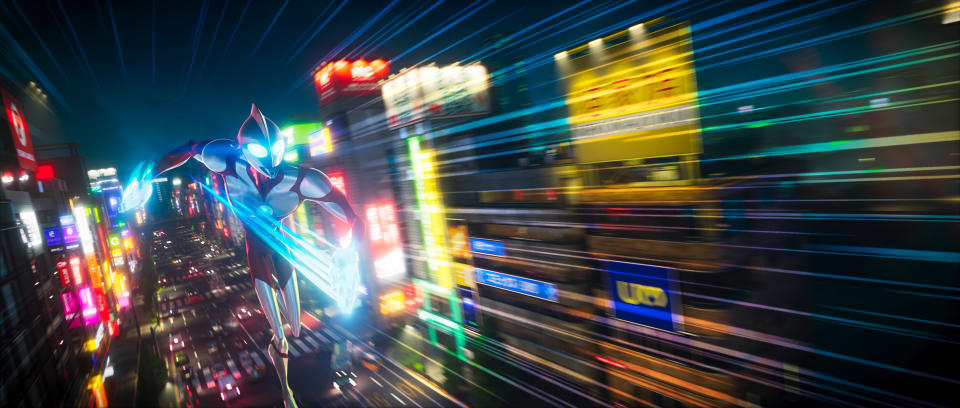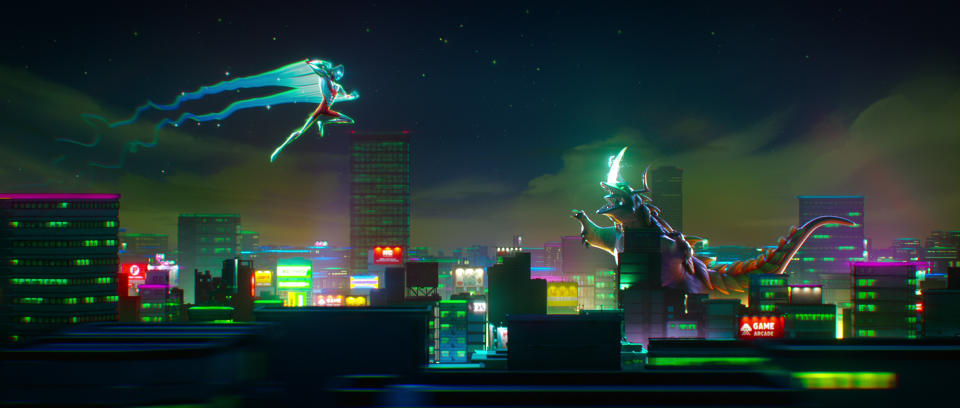‘Ultraman: Rising’ Reinvents the Iconic Franchise with the Hand-Drawn Look of Manga and Anime

While ILM was completing the animation and VFX for Netflix‘s “Lost Ollie” (2022), the live-action/CG limited series about a floppy-eared toy trying to find its way back home, creator Shannon Tindle shared with them some of the manga- and anime-influenced artwork for his passion project with Netflix, “Ultraman: Rising” (currently streaming). His plan was to turn the Japanese pop culture phenomenon into an action-packed, heartwarming ode to parenthood and finding balance in life.
Tindle’s hope was to entice ILM into doing the animation, even though the VFX powerhouse hadn’t made an animated feature since the Oscar-winning “Rango” (2011). Gathered in his Burbank office, Tindle showed off examples of Ultraman’s iconic red and silver look, fighting kaiju in Tokyo and bonding with his adopted 35-foot, fire-breathing baby kaiju girl.
More from IndieWire
“It looked amazing and I was completely sold,” ILM VFX supervisor Hayden Jones told IndieWire. “We had some production design from Marcos [Mateu-Mestre] that had such a tremendous amount of detail and style to it. I wasn’t sure whether ILM wanted to get back into this area. We went and asked and took some artwork. And literally the first word out of everyone’s mouth was, ‘Yes, we have to do it.'”

ILM worked in London while finishing “Lost Ollie” but relied heavily on their Vancouver studio, performing look development for shaders and textures and setting up their model and character pipeline. Jones collaborated closely with animation supervisor Mathieu Vig and a team of talented animators who were big fans of Ultraman (Japan’s answer to Superman and Green Lantern). They finished shots in Singapore as well, particularly the complex end battle, which had a huge amount of simulated water effects.
While the 2D aesthetic looks deceptively simple, Jones insisted that it was complicated to crack. “We really wanted the style to feel pushed and stylized, but to also feel natural and not too confusing,” Jones said. “There’s a theme in ‘Ultraman: Rising’ about balance. And I think balance is a really good way of thinking how we achieved the style. On the one side, we were getting this very stylized, very illustrative, very two-dimensional artwork handed over to us in layered Photoshop files.
“And then we saw what Shannon and John Aoshima, the co-director, wanted for the kind of dynamic camera and dynamic lighting that was going to carry the style through,” added Jones. “And, initially, it was like: How do we marry those two styles together? What we did initially was we broke down all the individual layers and underlying all of this was your base layer. This was supposed to represent a kind of copic marker watercolor layer. And for that we leaned heavily into a Kuwahara filtering system that smooths out wide areas of very soft, gentle shading. So if you’ve got a soft shadow that’s rolling across the character’s face, that will blur it slightly and give you a marker-like finish. However, what it also does is keep those edges of the shadow really sharp.
“And so if you build part of it into your shade and part of it into your composite, you can control it and fine-tune it to give you a beautiful marker-like feel. And it’s gonna move dynamically and it’s going to be impacted by the lighting completely.”

The line work was also a complex issue, requiring a procedural solution using Houdini software to generate large amounts of lines over multiple characters and throughout the scene automatically. This also allowed the animators to control line weight that was put through a randomization. The crucial thing, though, was creating a paper texture underneath. All of this combined to provide a naturalistic incline.
But there were unforeseen problems, such as not being able to control lines that appeared on character faces. So what they ended up doing was clearing the face and writing a rigged line system. This gave the animators complete control over all of the lines. “As the animators were animating the performance, they were also inking the line work over the important features of the face,” Jones said.
There were also the massive Tokyo scenes that required a dedicated toolset to keep the style consistent throughout so much complexity and destruction. “One of my favorite pieces of line work was where Gigantron is flying through the clouds and being pursued,” added Jones. “And if you look carefully, all the clouds have a really subtle ink line. So even though they’re soft and volumetric, there’s still small amounts of definition. And it gives you the feeling that everything’s been generated from 2D, but it all works three-dimensionally and comes together as a whole.”

Tindle also wanted to insert graphic streaks in color and black-and-white to punctuate Ultraman’s emotional highs and lows since baseball superstar Ken Sato (Christopher Sean) reluctantly returns home to take on the superhero mantle from his father (Gedde Watanabe). These marker renderings were inspired by particular manga cover illustrations. “We called them Otomo moments,” Jones said, “because when we first started talking to Shannon and the art department, they were looking at a lot of artwork from Katsushiro Otomo, who created ‘Akira.’ There were panels that flood with color, and that’s the feeling that Shannon wanted to get to visually show the emotion going on in a scene, whether it’s anger or the baby [keiju] crying.”
One such moment occurs when Ultraman holds the baby for the first time, and behind him the clouds part, and there’s what looks like a child’s mobile in the background. “And we literally used some artwork for that,” added Jones. “We took the Photoshop file and dropped it into the background, and we layered it in the composite in 3D so we could have a little bit of separation and then gave it a small amount of camera nuance.”
Meanwhile, Ultraman was one of the trickiest characters to bring to life. He essentially can’t move his face, he’s a complete mask, so he never has any lip movement, doesn’t have any eyebrows, nothing that we normally associate with a character. “We took a small liberty with the original Ultraman character, whose eyes light up and look forward,” Jones said. “So we gave Ultraman pupils and allowed for intensity changes in the eye as well. Just doing really subtle eye darts was very successful. And the shading is quite complex because, again, the balance between illustration and three-dimensional rendering means that we have to start thinking about how that stylization works with reflections, as most of Ultraman is a reflective surface.

“So, again, we go back to Kuwahara filtering, but also we looked at how [art director] Sunmin Inn took some of the reflections and sharp edges in the reflections and put little smears on the edges,” added Jones. “So nothing was perfect, everything was slightly soft, slightly stylized in the way they were rendered. So we worked with Marco Firme, the texture lead, to create multiple layers of unseen helper textures that helped the composite team go in and smear the edges of some of these reflections to impersonate the illustrative artwork. We used the same technique on Ken’s hair [Tindle referenced Toshiro Mifune], which is a solid block that we were able to rig and give animators complete control.”
One of the coolest effects, though, was Ken’s transformation into Ultraman as a light force, spearheaded by Aleksei Chernogorod, ILM’s associate VFX supervisor in Singapore. “Ultraman comes from a land of light, and so a lot of his energy is light-based,” Jones explained. “He has the Spacium Beam, which is a kind of light blast. He has the Ultra Slash, which is like a circular saw blade that he can throw at kaiju. We wanted to get the feeling that, when Ultraman transformed, he was reforming into a different spectrum of light. So I had a deep conversation with Shannon and we imagined that as he transforms we split it up into a kaleidoscope and it forms a rainbow, and as he shrinks, the rainbow shows an echo of what it’s like.
“So we did a lot of testing and created a graphic image on every single frame,” Jones added. “But we had to make sure that the effect worked. Whether you were seeing it full frame at full speed or whether you just caught two or three frames of it, it had to register. I think they created a really nice system so that we could kind of play to the strengths of the composite and really time out each individual frame and each individual color.”
Best of IndieWire
Sign up for Indiewire's Newsletter. For the latest news, follow us on Facebook, Twitter, and Instagram.
Solve the daily Crossword

